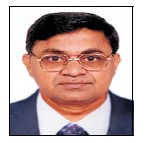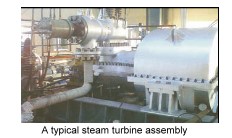
Industrial steam turbines represent one of the largest population of prime
movers in the world. They are found in many industries and utilized in a
variety of applications. Steam turbines are classified according to the heat
drop process as condensing, extraction cum condensing, back pressure turbines.
Arani Power Systems Ltd offers steam turbines up to 45 mw in all three types of
condensing, extraction cum condensing and back pressure turbines to cater
different needs. As the inlet pressure and temperature of steam turbine
increases thermal efficiency of steam turbine improves. Our steam turbines are
designed to handle up to the inlet pressure and temperature of 125 ata and
535ºC respectively. This is achieved by using high chromium percentage steels
that enable steam turbines to reach pretty elevated steam temperatures. These
designs are developed by implementation of new advanced approaches like CFD
and FEM codes for better steam path design and reliability. Use of twisted and
tapered blades and diffuser in LP stages reduce exit energy losses and increase
the steam turbine efficiency.
When it comes to condensing turbines the steam leaves the steam turbine
below atmospheric pressure, besides steam is also extracted from
intermediate stages for feed water heating to improve the overall efficiency.
Usually smaller capacity turbines up to 5-mw techno-economically are not
viable for feed water heating. Arani provides this regenerating heating
provision in higher capacity turbines.
In extraction-cum-condensing turbines defined quantity of steam will be
extracted at specific pressure and temperature to meet the industrial process
requirement. Arani offers controlled extraction steam parameters up to 25 ata.
In a recent sugar cogen project, Arani has given one controlled extraction of
125 tph (tonne per hour) and wander extraction design to meet the process
requirement in season and off-season condition.
In the case of back pressure
turbines, the exhaust steam is
directly utilized in the industrial
process. These turbines are relatively
small in size when compared to
condensing turbine as the leaving
steam has low specific volume.
PRODUCTION
PROGRAMME
OF ARANI
The Arani production programme for
industrial steam turbines comprises
several standardized type ranges of
the multi-stage, multi-valve, highly
efficient special-purpose type
turbines. Dependent on the range,
turbines with a power output up to 45
mw and with speeds up to 8,000 rpm
can be offered. Our designs are
suitable up to 125 ata/535ºC. Arani make all types of industrial turbines like
back pressure type, condensing type,
extraction back pressure type,
extraction condensing type.
Uncontrolled extraction and wander
extraction can also be provided
wherever required.
SALIENT FEATURES OF
ARANI-MAKE TURBINES
All Arani industrial turbines are designed
even to meet the severe demands on
mechanical drive turbines irrespective of
the particular application.
Casing: All turbines have a horizontally
split outer casing and a steam chamber.
The double shell construction prevents
initial steam being in direct contact with
the outer casing joint. Steam Chamber
and Valve Chest are Integral. This
construction meets the mechanical design
aspects of high steam parameters. Casing
and valve chamber are bolted joint for low
pressure and temperature application.
Casing distortion cannot be transmitted to
the bearing because they are supported in
separate bearing pedestals. The casing is
cast from Cr-Mo-V, Cr-Mo-, Mo alloy
steels depending on the steam
parameters. These materials are creep
resistant and having better fatigue life.
Special tailor made designs are evolved by
applying rigorous stress analysis and heat
transfer calculations by using finite
element analysis (FEM).
Steam Admission: The emergency stop
valve welded to the steam chest. The
control vales are suspended on a bar which
is moved by two spindles. Therefore only
two stuffing boxes are necessary for
passing the spindles through the casing.
The flow path in the steam chest is
designed by using latest CFD technique to
minimize the flow losses.
Blading: Impulse blading is used for the
control stage with partial admission to
improve part load performance and
sustained efficiency. HP stages also are
from impulse blading and have better
sustained performance with respect to
time. The HP blade profiles are developed
on geometrical scaling philosophy so the
all the profiles do exhibit geometrical
similarity properties. For all profile sizes
the optimal pitch ratio (pitch/profile
chord length) is selected.
In the design process all the cases are
integrated into program to improve
reliability of transition zone and to
maximize dynamic blade stresses.
Standardized blading used provides even
more reliability. In order to increase the
lowest natural frequency above accepted
speed multiple of more than 6, the aspect
ratio is limited. Low reaction blading is
used in IP stages to control height of the
blade where specific volume increases
more towards Low Pressure region.
Inverted T-root design with side grip and
fork root designs are used for fixing
blades to rotor.

The standardized last stages in
condensing turbines are made in various
sizes to meet condensing flow
requirements and various speeds. Their
blades are twisted and tapered and are
fitted with damping pins which are put
into holes in reinforced parts of the
blades. These pins are pressed against
the sides of the holes by centrifugal force,
producing the desired damping effect on
vibration. The blades of the last stages in
condensing turbines have been designed
for high mass flows. Proper pitch-tochord
ratios satisfy the higher stiffness
requirement of these blades to increase
the natural frequencies. And also the
steam bending moment is minimized
resulting in light dynamic blade force for
water cooled and air cooled condenser
applications. The blades are attached to
the rotor by wider fork roots and taper
pins. This type of designs shall result in
very close control over tolerances even in
smaller sizes, that all the prongs are
loaded uniformly. In other designs like
fir-tree, a departure from the close
tolerances can result in considerably
high peak stresses resulting in
elastoplastic fractures.
The low-pressure blading are made as a
series of geometrically similar blades. For
the same peripheral speed for every size of
blade the mechanical and aerodynamic
characteristics will also be same for every
blade size. At the outlet of last moving
blade, an exhaust diffuser is installed to
recover the exhaust energy of last moving
blades. 12-13% Cr-Mo-V stainless steels
are used for the blading which are creep
and fatigue resistant. These are less prone
to stress corrosion and pitting and are
having better material damping property.
Rotor and Bearing: The disc-type
rotors are used for Arani Impulse
turbines. The material of the rotor is
1.25 Cr,Mo,V low alloy steel which are
creep resistant. These materials which
Arani is using are having higher
toughness values of the order of
165MNm-3/2. The forgings are refined
by VCD process. Arani adopts impulse
bladed rotor design by taking advantage
of the positive features of impulse
design. The Axial thrust is taken care by
a bi-directional tilting pad thrust
bearing. The bearing range include
fixed pad to tilting pad type bearing to meet specific requirements of rotorbearing
system. The sealing strips in all
labyrinth glands can be renewed easily
in the event of wear. It is also possible to
fit complete spare glands.
Monitoring Devices: All Arani turbines
can be equipped with monitoring devices
for free movement of the emergency stop
valves and correct operation of over speed
trips. There are standard facilities for
fitting rotor vibration measuring pickups.
Steam Control Valve: For high
temperature and high pressure steam,
diffuser type single seat valves are
employed. Total four control valves are
used, fourth one will be designed for the
overload operation.
Protection Devices: The following
protection devices are provided to
ensure operational safety of turbo set:
main steam emergency stop valve;
steam strainer; Over-speed governor
(built into rotor); thrust bearing failure
protection device; emergency trip
device; solenoid trip device; low bearing
oil pressure tripping device; vacuum
tripping device; extraction check valve;
rotor relative expansion, and casing
differential expansion.
Standard and specifications: Arani
turbines satisfy the requirements of all the
usual international standards such as
API, IEC, NEMA, DIN etc and larger
number of user specifications. Arani's
efforts are geared towards meet the
demands of the present-day industry.
Arani offers packaged turbines taking
associated savings in time and ease in
erection into consideration. Arani is ready
with economical new design, without
compromising other characteristics of our
turbine range like higher efficiency, high
amount of reliability, easiness in
maintenance and long life.
(K. Ch. Peraiah is Managing Director,
Arani Power Systems Ltd)